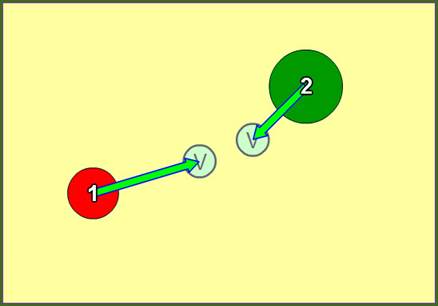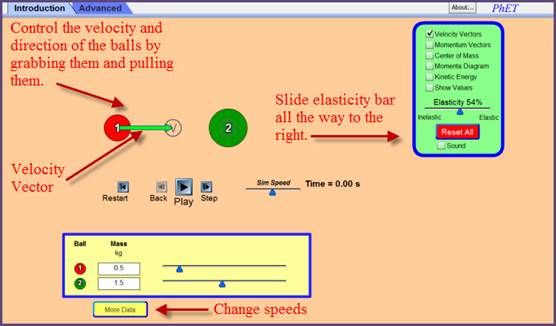
MOMENTUM LAB
Unit
Overview
When
objects move, they have momentum.
Momentum, p, is the product of an object’s mass (kg) and its velocity
(m/s). The unit for momentum, p, is kg·m/s. During a
collision objects transfer momentum to each other, resulting in different
motions than before the collision. In
this activity you will study the motion colliding objects by manipulating a
simulation to observe two different kinds of collisions; elastic and inelastic.
You will also be able to see how momentum and kinetic energy are conserved
after a collision. You will also be able to calculate momentum and kinetic
energy before and after a collision.
Part
I- Elastics Collisions
Procedure
1. Go to the website and run
the simulation. http://phet.colorado.edu/en/simulation/collision-lab
2. Click on the more data button at the bottom
of the simulation to change speeds easier.
3. The graph below is what you will see on the
simulation page. Slide the elasticity bar all the way to the right.
4. You can control the velocity and direction
of the balls by grabbing them and pulling them. You will see a green arrow
which is your velocity vector, or you can control velocity and mass of the
balls by typing the information into the data table.

Download
the printable worksheet below, you will use the worksheet to record all of your
lab information. You will attach your worksheet to question #1 in the question
section of this unit.
A
Look Ahead
In the
next unit, we will be reviewing for the semester exam. You will be asked to
complete a series of questions that we have covered in the previous units. This
will help you to focus on the important concepts covered for the semester exam.
You will have to recall information from the labs as well. It is a good idea to
put together an equation sheet of all the equations that we have learned so
far, so that answering the questions and problems will be easier and less time
consuming.

Below are additional educational resources and activities for this unit.